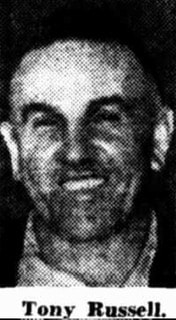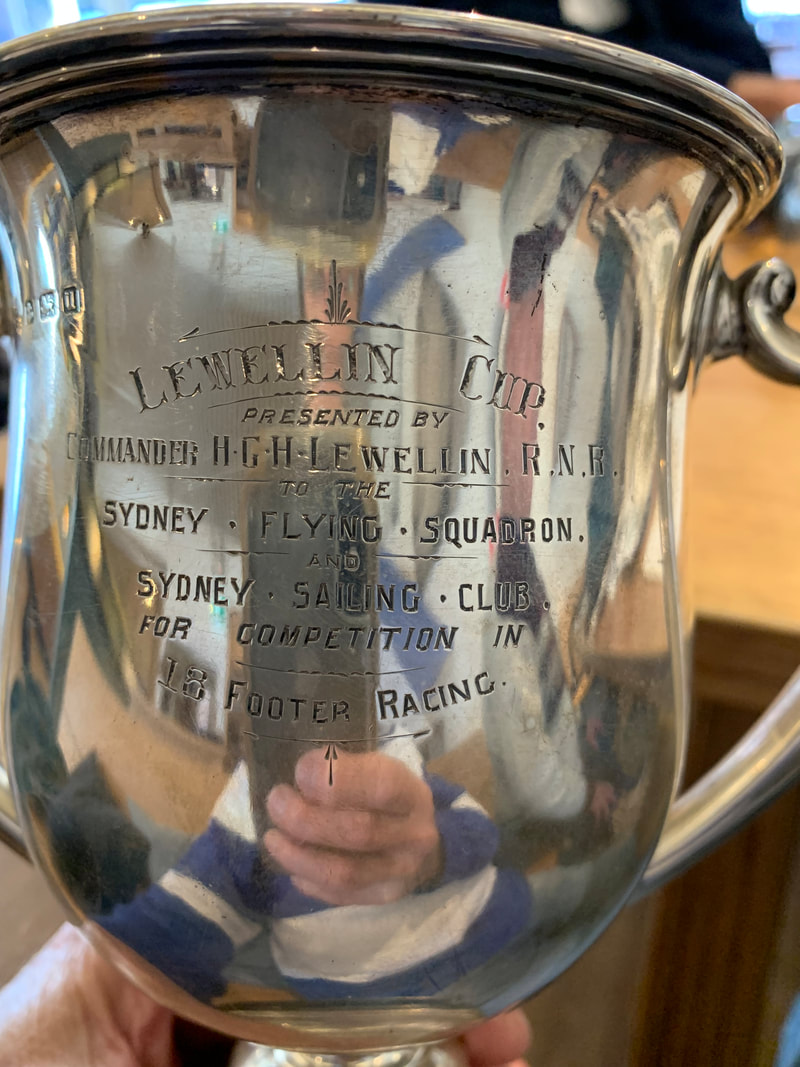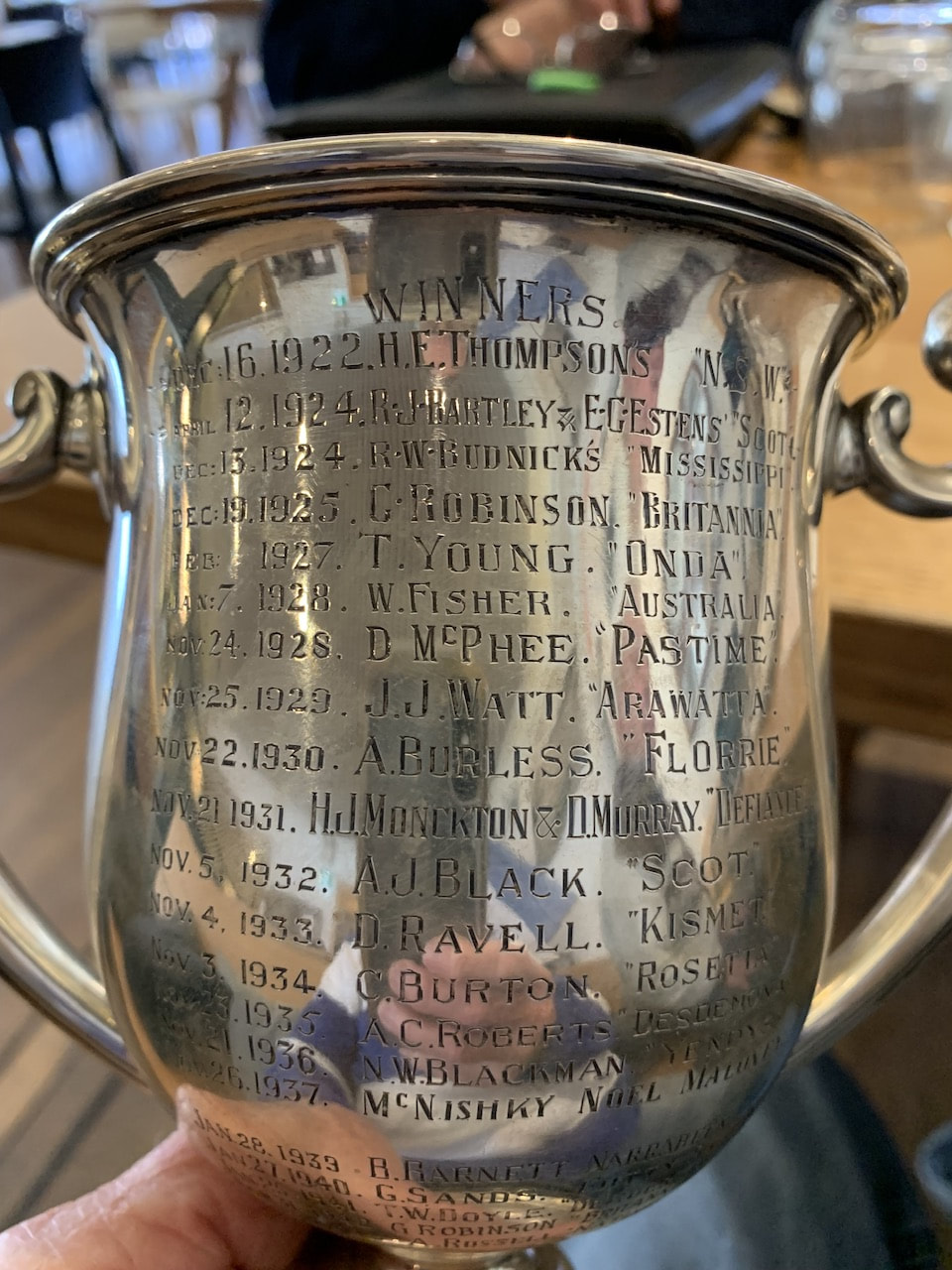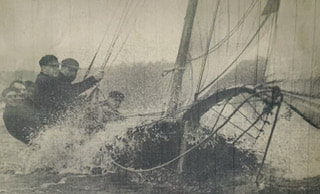Among the many trophies in the collection of the Sydney Flying Squadron is the Lewellin Cup, presented by Commander Lewellin in 1922, and competed for until 1943. Like most of the Squadron’s trophies there are many stories involved with this cup.
Herbert Gordon Hill Lewellin was born in Melbourne and ran away to sea, taking an apprenticeship on the clipper ship Romanoff (actually through connections from his schooling with the Templeton family). He moved over to mateships and captaincy with the Loch line, and prior to World War I had joined P& O, and when war broke out he was the skipper of the Mongolia doing regular trips between Australia and Britain.
In July 1917 the ship struck a mine in the Arabian Sea off Bombay (believed to have been laid by the raider Emden’s consorts) and sank within 13 minutes. Five officers and 23 crew were killed in the explosion, but Captain Lewellin was a respected man with a loyal and well-trained crew and all survivors were put into surviving lifeboats and Lewellin and his officers were the last to abandon ship other than one crewman who was afraid to jump into the water but eventually did. Lewellin had a small terrier dog aboard which appeared lost, but Lewellin spotted it from the lifeboat, dived over and spent an hour or more in the water eventually saving the dog. All boats reached the Indian shore without loss.
Herbert Gordon Hill Lewellin was born in Melbourne and ran away to sea, taking an apprenticeship on the clipper ship Romanoff (actually through connections from his schooling with the Templeton family). He moved over to mateships and captaincy with the Loch line, and prior to World War I had joined P& O, and when war broke out he was the skipper of the Mongolia doing regular trips between Australia and Britain.
In July 1917 the ship struck a mine in the Arabian Sea off Bombay (believed to have been laid by the raider Emden’s consorts) and sank within 13 minutes. Five officers and 23 crew were killed in the explosion, but Captain Lewellin was a respected man with a loyal and well-trained crew and all survivors were put into surviving lifeboats and Lewellin and his officers were the last to abandon ship other than one crewman who was afraid to jump into the water but eventually did. Lewellin had a small terrier dog aboard which appeared lost, but Lewellin spotted it from the lifeboat, dived over and spent an hour or more in the water eventually saving the dog. All boats reached the Indian shore without loss.
Lewellin spent the rest of the war commanding transports between America and France. After the war he was given the P&O “gem” Naldera trading between Britain and Australia. He loved sailing and crewed on 18-footers whenever the ship was in Sydney. In 1922 he commissioned the silver Lewellin Cup to be awarded for 18-footer sailing in both the SFS and the Sydney Sailing Club (who of course merged with the SFS in 1925).
The list of winners includes many of the stalwarts of the fleet over the period. The first winner in December 1922 was Harry Thompson in his new boat NSW. Scot won it the following season in April 1924, and also won it once more as Scot and a third time, the final contest, as Native in 1943. The other names include Britannia (twice) and Yendys. There are stories associated with every one of the winners.
The list of winners includes many of the stalwarts of the fleet over the period. The first winner in December 1922 was Harry Thompson in his new boat NSW. Scot won it the following season in April 1924, and also won it once more as Scot and a third time, the final contest, as Native in 1943. The other names include Britannia (twice) and Yendys. There are stories associated with every one of the winners.

The final winner was Tony Russell in Native (née Scot). Tony was a Balmain boy who epitomizes the linked rough and tough worlds of open boat sailing and Rugby League. He played first grade for the Balmain Tigers, sailed 10-footers and 18-footers eventually becoming skipper of boats at both the SFS and the League including Native, and winning the JJGiltinan World Championship in Marjorie Too in Sydney in 1949. His football career is most famous for the Earl Park riot in July 1928. A tough match with St George at Earl Park in Arncliffe saw many incidents including Russell flattening a St George player ‘Bluey’ Carstairs and stepping on his head. Other fights broke out between players after the final whistle, and the crowd spilled onto the ground and joined in with ripped-off fence palings, Protective Balmain supporters shepherded Russell outside the ground, where badly cut about the head and legs an ambulance was called. In the excitement Russell and Carstairs were put in the same ambulance and the fight resumed. Russell always maintained that Carstairs had started the fight on the field. Police charges were eventually dropped, but Russell only spent one more season at the Tigers and went to play in Canowindra.
And there’s even more connection with sailing in Australia through Tony Russel: his son Barry sailed with Vic Robinson on the 18-footer The Fox including winning the Australian Championship in 1960-61 and went on to join the crew of 1962 America’s Cup challenger Gretel.
So check out the Lewellin Cup next time you’re down at the Squaddie, and have a look at the other trophies, there’s stories behind every one.
And there’s even more connection with sailing in Australia through Tony Russel: his son Barry sailed with Vic Robinson on the 18-footer The Fox including winning the Australian Championship in 1960-61 and went on to join the crew of 1962 America’s Cup challenger Gretel.
So check out the Lewellin Cup next time you’re down at the Squaddie, and have a look at the other trophies, there’s stories behind every one.
Tony Russell steered Native with great success for several seasons during the Second World War.


